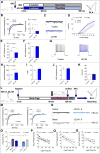Functional Redundancy Between Canonical Endocannabinoid Signaling Systems in the Modulation of Anxiety
- PMID: 28438413
- PMCID: PMC5585044
- DOI: 10.1016/j.biopsych.2017.03.002
Functional Redundancy Between Canonical Endocannabinoid Signaling Systems in the Modulation of Anxiety
Abstract
Background: Increasing the available repertoire of effective treatments for mood and anxiety disorders represents a critical unmet need. Pharmacological augmentation of endogenous cannabinoid (eCB) signaling has been suggested to represent a novel approach to the treatment of anxiety disorders; however, the functional interactions between two canonical eCB pathways mediated via anandamide (N-arachidonylethanolamine [AEA]) and 2-arachidonoylglycerol (2-AG) in the regulation of anxiety are not well understood.
Methods: We utilized pharmacological augmentation and depletion combined with behavioral and electrophysiological approaches to probe the role of 2-AG signaling in the modulation of stress-induced anxiety and the functional redundancy between AEA and 2-AG signaling in the modulation of anxiety-like behaviors in mice.
Results: Selective 2-AG augmentation reduced anxiety in the light/dark box assay and prevented stress-induced increases in anxiety associated with limbic AEA deficiency. In contrast, acute 2-AG depletion increased anxiety-like behaviors, which was normalized by selective pharmacological augmentation of AEA signaling and via direct cannabinoid receptor 1 stimulation with Δ9-tetrahydrocannabinol. Electrophysiological studies revealed 2-AG modulation of amygdala glutamatergic transmission as a key synaptic correlate of the anxiolytic effects of 2-AG augmentation.
Conclusions: Although AEA and 2-AG likely subserve distinct physiological roles, a pharmacological and functional redundancy between these canonical eCB signaling pathways exists in the modulation of anxiety-like behaviors. These data support development of eCB-based treatment approaches for mood and anxiety disorders and suggest a potentially wider therapeutic overlap between AEA and 2-AG augmentation approaches than was previously appreciated.
Keywords: 2-Arachidonoylglycerol; Amygdala; Anxiety; JZL184; MAGL inhibition; Stress.
Copyright © 2017 Society of Biological Psychiatry. Published by Elsevier Inc. All rights reserved.
Conflict of interest statement
All other authors report no biomedical financial interests or potential conflicts of interest.
Figures





Comment in
-
From "Azalla" to Anandamide: Distilling the Therapeutic Potential of Cannabinoids.Biol Psychiatry. 2018 Jan 15;83(2):e27-e29. doi: 10.1016/j.biopsych.2017.11.017. Biol Psychiatry. 2018. PMID: 29223222 Free PMC article. No abstract available.
References
-
- Investing in treatment for depression and anxiety leads to fourfold return. WASHINGTON DC, USA: World Health Organization: Media Center; 2016. Apr 13, 2016.
-
- Reeves RR, Ladner ME. Antidepressant-induced suicidality: implications for clinical practice. South Med J. 2009;102:713–718. - PubMed
-
- Lader M, Kyriacou A. Withdrawing Benzodiazepines in Patients With Anxiety Disorders. Curr Psychiatry Rep. 2016;18:8. - PubMed
-
- Uhlenhuth EH, Balter MB, Ban TA, Yang K. International study of expert judgment on therapeutic use of benzodiazepines and other psychotherapeutic medications: IV. Therapeutic dose dependence and abuse liability of benzodiazepines in the long-term treatment of anxiety disorders. J Clin Psychopharmacol. 1999;19:23S–29S. - PubMed
MeSH terms
Substances
Grants and funding
LinkOut - more resources
Full Text Sources
Other Literature Sources
Medical

